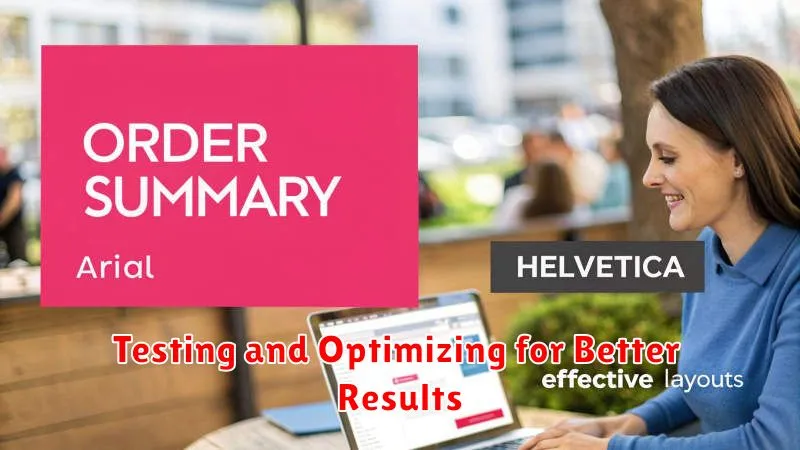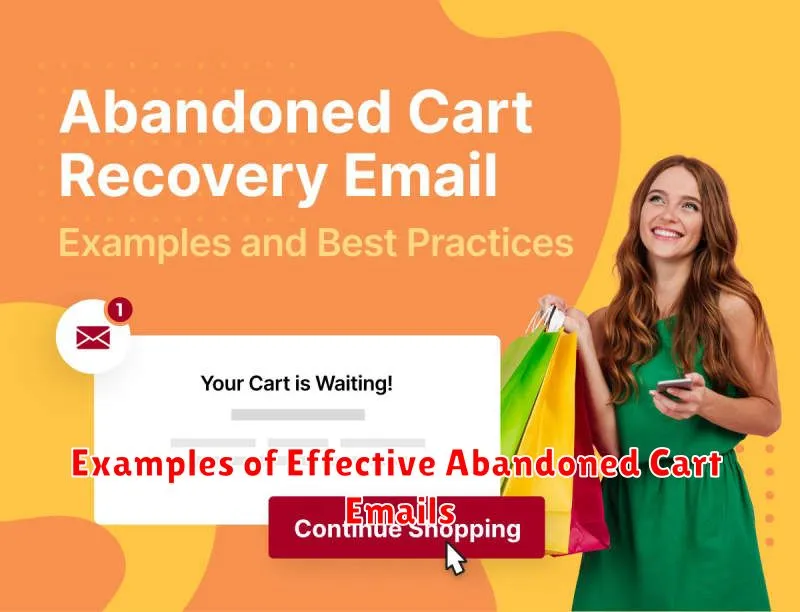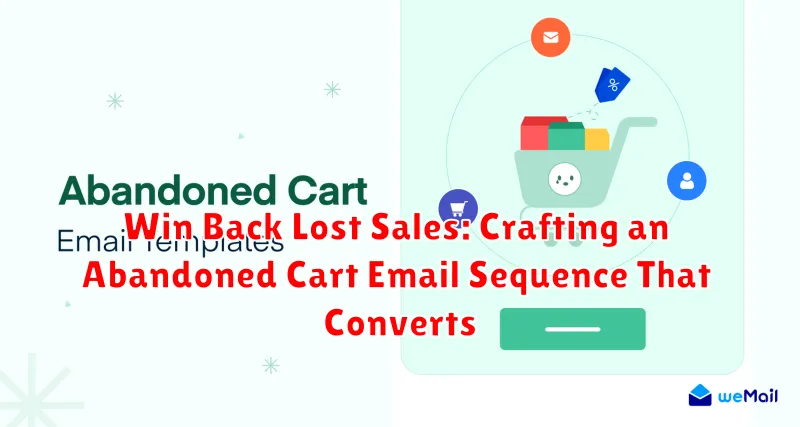Are you losing potential revenue due to abandoned carts? It’s a common eCommerce woe, but not an insurmountable one. Recapturing those lost sales is crucial for maximizing your conversion rate and boosting your bottom line. A strategically crafted abandoned cart email sequence can effectively re-engage those shoppers who left items in their cart and persuade them to complete their purchase. Learn how to transform abandoned carts into conversions by implementing an email strategy that reminds, incentivizes, and ultimately wins back your customers.
This article will delve into the essential elements of a high-converting abandoned cart email sequence. We’ll cover best practices for crafting compelling subject lines, personalizing email content, and offering strategic incentives. Discover how to optimize your email timing, segment your audience, and leverage social proof to effectively re-engage shoppers and transform those abandoned carts into conversions. By implementing the strategies outlined here, you’ll be well on your way to recovering lost revenue and improving your overall eCommerce performance.
Understanding Cart Abandonment and Its Impact
Cart abandonment is a significant challenge for online businesses. It occurs when a potential customer adds items to their online shopping cart but leaves the website without completing the purchase.
The impact of cart abandonment can be substantial, leading to a direct loss in potential revenue. High abandonment rates signify missed sales opportunities and decreased profitability. Understanding the reasons behind this behavior is crucial for implementing effective recovery strategies.
Several factors contribute to cart abandonment. Unexpected costs, such as high shipping fees or taxes, are a common deterrent. A complicated checkout process can also frustrate customers and lead to abandonment. Security concerns regarding payment information can also play a role.
Analyzing cart abandonment data can provide valuable insights into customer behavior. This data can inform targeted strategies to improve the user experience and ultimately increase conversion rates.
The Power of an Abandoned Cart Email Sequence
An abandoned cart email sequence is a powerful tool for recovering lost revenue and re-engaging potential customers. By strategically sending a series of emails, you can remind shoppers about the items they left behind and encourage them to complete their purchase. This automated process allows you to connect with a significant portion of shoppers who would have otherwise been lost.
The key strength of a sequence lies in its ability to nurture these potential customers. Rather than a single reminder, a sequence allows for a more persuasive approach, offering incentives, highlighting product benefits, and building a sense of urgency.
Conversion rates for abandoned cart emails are significantly higher than typical marketing emails, demonstrating their effectiveness in driving sales. A well-crafted sequence can re-capture a substantial portion of lost revenue and contribute significantly to your bottom line.
Furthermore, these sequences offer valuable insights into customer behavior. By analyzing open and click-through rates, you can identify areas for improvement in your overall sales funnel and refine your marketing strategies.
Best Practices for Writing Abandoned Cart Emails
Crafting effective abandoned cart emails requires attention to detail and a customer-centric approach. Personalization is key. Address the customer by name and reference the specific item(s) left in their cart.
Clarity is crucial. Clearly state the purpose of the email – to remind them about their abandoned items. Include a prominent call to action, such as “Return to Cart” or “Complete Your Purchase,” making it easy for them to proceed.
Incentivize the purchase. Offering a discount, free shipping, or a limited-time offer can be the nudge a customer needs to complete their order. Highlighting the benefits of your product or any guarantees you offer can also be effective.
Maintain a consistent brand voice and ensure your email design aligns with your overall brand identity. Keep the email concise and easy to read on various devices.
Timing is Key: When to Send Your Abandoned Cart Emails
The timing of your abandoned cart email sequence is crucial for maximizing its effectiveness. Sending emails too soon can feel pushy, while waiting too long might result in the customer losing interest or purchasing elsewhere.
A common and effective strategy is the three-email sequence, with specific timing guidelines for each:
Email 1: The Reminder
Send this email approximately one hour after the cart is abandoned. This serves as a gentle nudge, reminding the customer of the items they left behind. Assume they were simply distracted and offer helpful customer service if they encountered any issues.
Email 2: The Incentive
Send the second email roughly 24 hours after abandonment. If the reminder wasn’t enough, this email sweetens the deal. Offer an incentive, such as free shipping, a small discount, or a limited-time promotion to encourage them to complete the purchase.
Email 3: The Last Chance
This final email, sent approximately 72 hours after abandonment, creates a sense of urgency. Reiterate the value proposition of your products and remind them of the expiring incentive. This can be the final push needed to convert the sale.
Crafting Compelling Subject Lines
Your abandoned cart email subject line is the first, and sometimes only, impression you make. A compelling subject line is crucial to getting your email opened. It should be concise, intriguing, and create a sense of urgency or exclusivity.
Consider using these tactics to craft subject lines that grab attention:
- Personalization: Include the customer’s name or mention the specific item left behind.
- Urgency: Highlight a limited-time offer or dwindling stock.
- Curiosity: Pose a question or hint at the contents of the abandoned cart.
- Benefit-driven: Emphasize the value proposition, such as free shipping or a discount.
Examples of effective subject lines:
- “[Customer Name], did you forget something?”
- “Still thinking about it? Your cart is waiting.”
- “Don’t miss out! Your [item name] is almost gone.”
- “Complete your purchase and get free shipping!”
Test different subject lines to see what resonates best with your audience. Analyzing open rates and click-through rates will help you optimize your subject lines for maximum impact.
Showcasing Product Value and Benefits
A key aspect of recovering abandoned carts lies in reminding customers why they added those items in the first place. Clearly showcasing the value and benefits of the products can reignite their interest and encourage them to complete the purchase. Don’t simply list the product name and image; reiterate the key features that make it desirable.
Highlight unique selling propositions. What makes your product stand out from competitors? Is it the superior quality, innovative design, or exceptional customer service? Emphasize these differentiators to reinforce the value proposition.
Use compelling product descriptions. Go beyond basic details and focus on the benefits customers will receive. Instead of stating “100% cotton,” explain how the soft, breathable fabric enhances comfort. Address potential pain points and explain how the product provides a solution.
Consider incorporating social proof, such as customer testimonials or reviews, to further build trust and confidence in the product’s value.
Creating a Sense of Urgency
A key element in recovering abandoned carts is instilling a sense of urgency. Customers often abandon carts due to simple distractions. A gentle nudge reminding them of their chosen items can be highly effective. This can be achieved through several tactics.
Limited-time offers are a powerful motivator. Highlighting that a sale price is expiring soon, or that stock is limited for a particular item, can encourage immediate action. Phrases like “Don’t miss out!” or “While supplies last” contribute to this sense of urgency.
Another effective method is setting a deadline for held items. Explain that the cart’s contents are reserved only for a limited time, after which they will be returned to general inventory. This creates a fear of missing out and encourages customers to complete their purchase.
Offering Incentives and Discounts
A strategic approach to recovering lost sales involves offering targeted incentives and discounts within your abandoned cart email sequence. This can be the tipping point for customers hesitant about completing their purchase.
Consider offering a small percentage discount, such as 5% or 10% off, to incentivize immediate action. Free shipping can also be a powerful motivator, especially if shipping costs were a factor in cart abandonment. Another effective tactic is a limited-time offer, creating a sense of urgency.
Present these offers clearly and concisely within your emails. Highlight the value proposition by explicitly stating the discount amount or the benefit of free shipping. For example, use phrases like “Get 10% off your order” or “Enjoy free shipping on your abandoned items.”
Be mindful of your profit margins when offering discounts. Calculate the potential return on investment to ensure the incentive is financially viable while still enticing enough for customers.
Personalizing the Email Experience
Generic abandoned cart emails often fall flat. Personalization is key to re-engaging customers and driving conversions. By using the customer’s name and referencing the specific product(s) left behind, you create a more targeted and impactful message.
Consider incorporating dynamic content that displays product images, descriptions, and even personalized recommendations based on past browsing history. This reminds the customer of what they’re missing and showcases relevant alternatives.
Segmentation also plays a crucial role in personalization. Tailor messaging based on customer demographics, purchase history, or website behavior. For example, first-time shoppers may respond better to reassurance about security and shipping, while repeat customers might be enticed by exclusive offers.
Testing and Optimizing for Better Results

Continuously testing and optimizing your abandoned cart email sequence is crucial for maximizing its effectiveness. A/B testing allows you to compare different versions of your emails to determine which performs best. Experiment with various elements, such as:
- Subject lines: Test different phrasing, lengths, and emojis to see what grabs attention.
- Email copy: Experiment with different tones, calls to action, and benefit-driven language.
- Send times: Determine the optimal times to send your emails based on your target audience’s behavior.
- Incentives: Test different discount amounts or free shipping thresholds to find the sweet spot.
Analyze the results of your A/B tests, paying close attention to open rates, click-through rates, and conversion rates. Use this data to refine your email sequence and iterate on what works best. Regularly reviewing and updating your strategy based on performance data ensures your abandoned cart emails remain effective and continue driving conversions.
Examples of Effective Abandoned Cart Emails

Subject: Still thinking about it?
This simple, direct subject line creates curiosity and reminds the customer of their unfinished purchase. The email body could then showcase the abandoned items with a clear call to action to complete the purchase.
Subject: Did you forget something? Your [Company Name] cart is waiting!
This subject line uses a slightly more playful tone while still highlighting the abandoned cart. The email could include images of the abandoned items and offer a small incentive, such as free shipping, to encourage completion.
Subject: We saved your cart!
This reassures the customer that their items are still available and makes the checkout process feel easy. This email might showcase customer testimonials or highlight key product benefits alongside the saved cart items.
Subject: Complete your purchase and get 10% off!
Offering an immediate discount can be highly effective. This subject line clearly states the benefit of returning to complete the purchase. The email could emphasize the limited-time nature of the offer.

